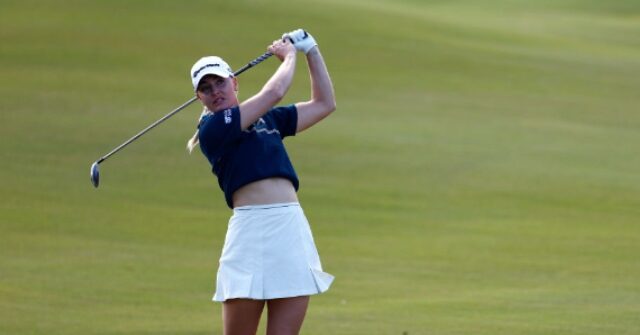The “Trump Dance” has emerged as a viral celebration among athletes across various sports, captivating fans in the NFL, college football, and even the UFC. One notable demonstration of this phenomenon occurred when Charley Hull, a promising British golf star and the twelfth-ranked female golfer in the world, performed the dance during the final round of The Annika tournament. Hull’s spirited display came as she competed against the top-ranked female golfer, Nelly Korda. The occurrence marked a significant moment, as it illustrated the cross-cultural appeal of the Trump Dance, highlighting how it has transcended national boundaries within the increasingly globalized sports community. Despite Hull’s enthusiastic performance, Korda ultimately triumphed in the tournament, securing her win by three shots.
The spread of the Trump Dance in American sporting circles has been remarkable, with an increasing number of NFL players joining in on the trend. On the same Sunday that Hull showcased her rendition, NFL players like Las Vegas Raiders tight end Brock Bowers were seen celebrating touchdowns with their own versions of the dance. The movement has gained traction, with notable instances including Lions defenders Za’Darius Smith and Malcolm Rodriguez, as well as Tennessee Titans receivers Calvin Ridley and Nick Westbrook-Ikhine also partaking in the celebration during their games. The dance effectively embodies the camaraderie and joy that athletes often display when celebrating their accomplishments on the field.
In a particular incident, Brock Bowers expressed his excitement about the Trump Dance in an interview, mentioning that he had seen it during a recent UFC fight featuring Jon Jones, which fueled his desire to try it himself. However, his enthusiasm was abruptly cut short when the Raiders’ public relations team ended his media availability right after he made those comments. Such actions by PR teams in professional sports highlight the delicate relationship between athletes and media narratives, particularly when it comes to topics that may evoke strong reactions or associations.
Despite the wave of popularity and playful nature behind the Trump Dance, the abrupt conclusion of Bowers’s media session raises questions about how organizations manage their public image in relation to their athletes’ personal expressions, particularly when these expressions may tie into politically charged themes. The decision by the Raiders’ PR team to intervene could reflect a desire to maintain a neutral stance, especially in a polarized political climate where associations with public figures like Donald Trump can provoke varied responses among fans and the wider public.
This interplay between personal expression and organizational response is critical to understanding the broader implications of movements like the Trump Dance in sports culture. As athletes like Bowers embrace these trends, they have the power to influence their fanbase and promote a sense of unity and excitement. Conversely, the actions of the PR teams underline the significant stakes involved when athletes become personalities with opinions and behaviors that may intersect with political issues. This relationship ultimately shapes how athletic culture evolves in a dynamic society.
As the Trump Dance continues to make waves in various sporting arenas, from golf to football, it remains a symbol of the interplay between sports, celebrity, and culture. The moments shared by athletes during games serve not only as entertainment but also reflect broader societal conversations and connections that transcend the sporting world. The implications of this dance—whether in uniting fans or stirring controversy—will likely resonate beyond the field, prompting further discussions about the role of athletes as influencers and the nuanced relationship they share with the media and their organizations.

